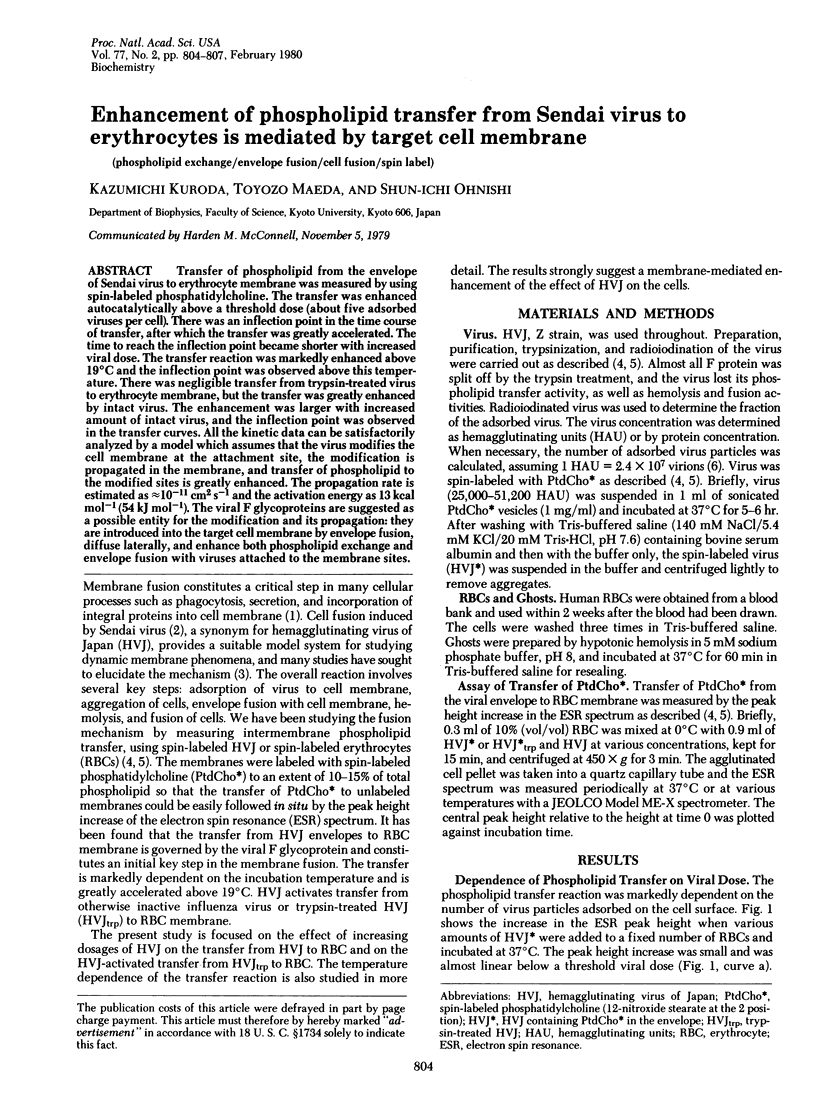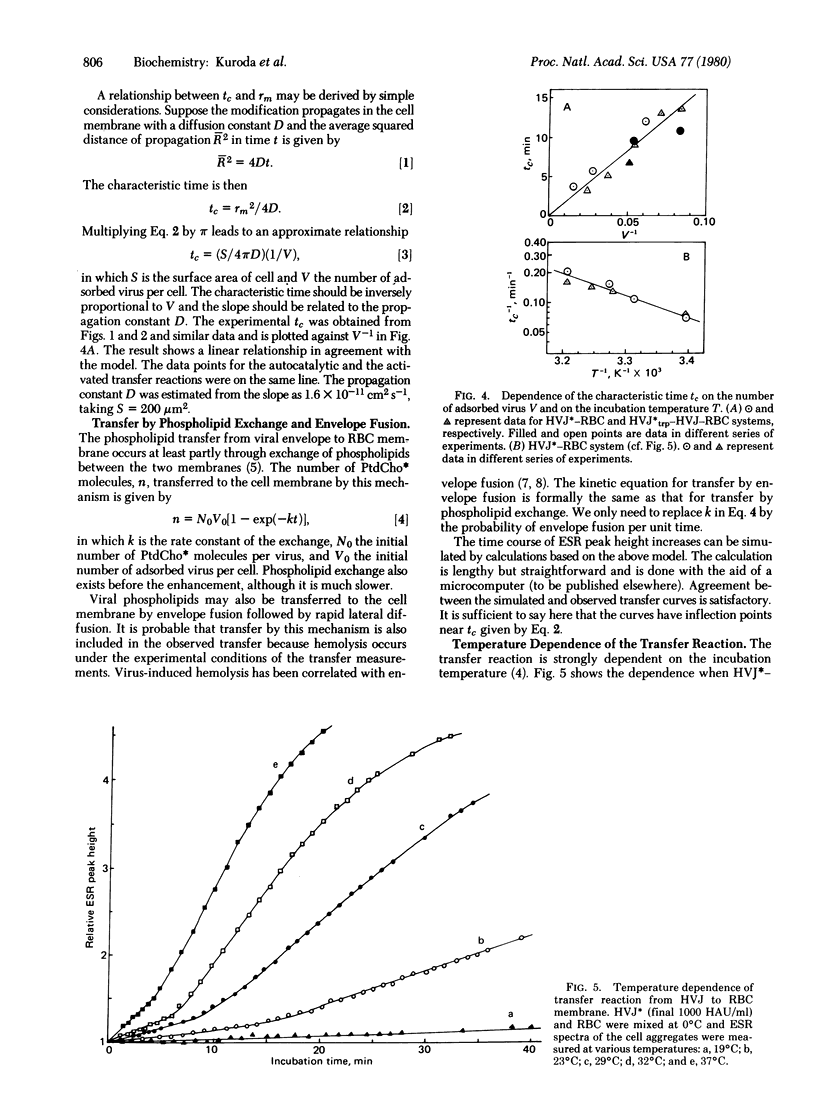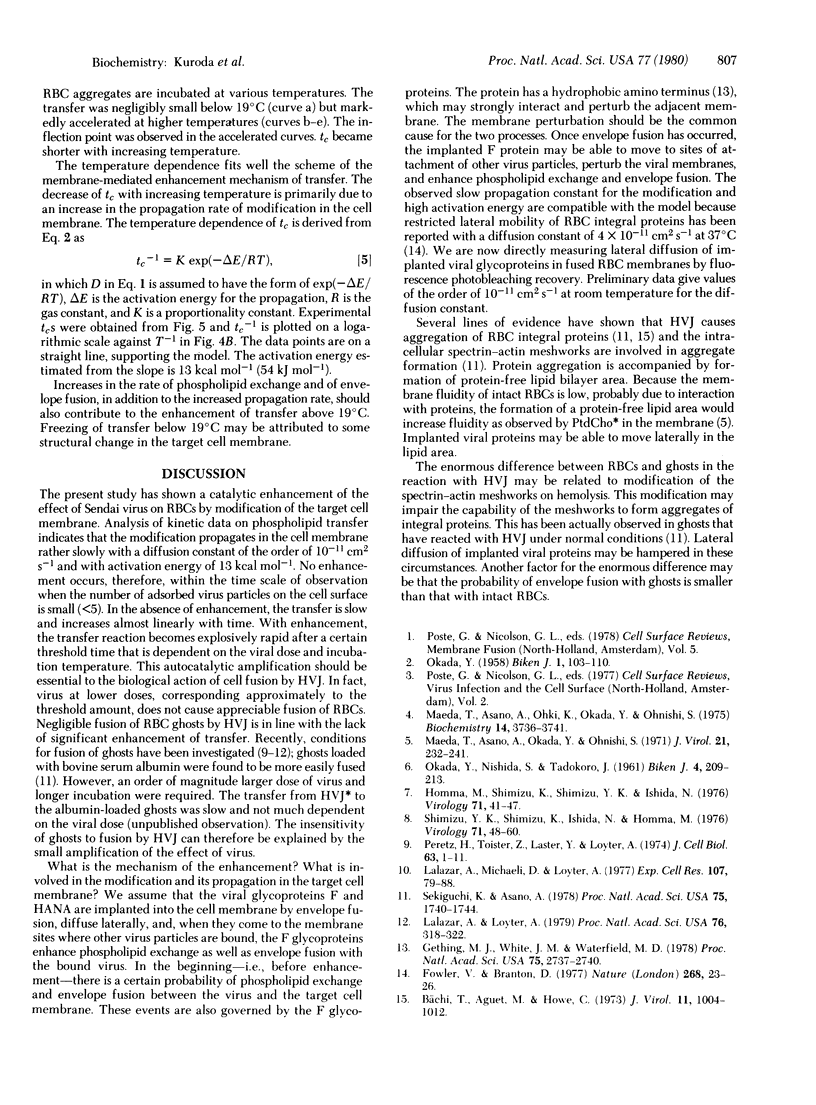Abstract
Transfer of phospholipid from the envelope of Sendai virus to erythrocyte membrane was measured by using spin-labeled phosphatidylcholine. The transfer was enhanced autocatalytically above a threshold dose (about five adsorbed viruses per cell). There was an inflection point in the time course of transfer, after which the transfer was greatly accelerated. The time to reach the inflection point became shorter with increased viral dose. The transfer reaction was markedly enhanced above 19 degrees C and the inflection point was observed above this temperature. There was negligible transfer from trypsin-treated virus to erythrocyte membrane, but the transfer was greatly enhanced by intact virus. The enhancement was larger with increased amount of intact virus, and the inflection point was observed in the transfer curves. All the kinetic data can be satisfactorily analyzed by a model which assumes that the virus modifies the cell membrane at the attachment site, the modification is propagated in the membrane, and transfer of phospholipid to the modified sites is greatly enhanced. The propagation rate is estimated as approximately equal to 10(-11) cm2s-1 and the activation energy as 13 kcal mol-1 (54 kJ mol-1). The viral F glycoproteins are suggested as a possible entity for the modification and its propagation: they are introduced into the target cell membrane by envelope fusion, diffuse laterally, and enhance both phospholipid exchange and envelope fusion with viruses attached to the membrane sites.
Full text
PDF



Selected References
These references are in PubMed. This may not be the complete list of references from this article.
- Bächi T., Aguet M., Howe C. Fusion of erythrocytes by Sendai virus studied by immuno-freeze-etching. J Virol. 1973 Jun;11(6):1004–1012. doi: 10.1128/jvi.11.6.1004-1012.1973. [DOI] [PMC free article] [PubMed] [Google Scholar]
- Fowler V., Branton D. Lateral mobility of human erythrocyte integral membrane proteins. Nature. 1977 Jul 7;268(5615):23–26. doi: 10.1038/268023a0. [DOI] [PubMed] [Google Scholar]
- Gething M. J., White J. M., Waterfield M. D. Purification of the fusion protein of Sendai virus: analysis of the NH2-terminal sequence generated during precursor activation. Proc Natl Acad Sci U S A. 1978 Jun;75(6):2737–2740. doi: 10.1073/pnas.75.6.2737. [DOI] [PMC free article] [PubMed] [Google Scholar]
- Homma M., Shimizu K., Shimizu Y. K., Ishida N. On the study of Sendai virus hemolysis. I. Complete Sendai virus lacking in hemolytic activity. Virology. 1976 May;71(1):41–47. doi: 10.1016/0042-6822(76)90092-1. [DOI] [PubMed] [Google Scholar]
- Lalazar A., Loyter A. Involvement of spectrin in membrane fusion: induction of fusion in human erythrocyte ghosts by proteolytic enzymes and its inhibition by antispectrin antibody. Proc Natl Acad Sci U S A. 1979 Jan;76(1):318–322. doi: 10.1073/pnas.76.1.318. [DOI] [PMC free article] [PubMed] [Google Scholar]
- Lalazar A., Michaeli D., Loyter A. Restoration of the fusion capacity of human erythrocyte ghosts by SH blocking reagents. Exp Cell Res. 1977 Jun;107(1):79–88. doi: 10.1016/0014-4827(77)90388-3. [DOI] [PubMed] [Google Scholar]
- Maeda T., Asano A., Okada Y., Ohnishi S. I. Transmembrane phospholipid motions induced by F glycoprotein in hemagglutinating virus of Japan. J Virol. 1977 Jan;21(1):232–241. doi: 10.1128/jvi.21.1.232-241.1977. [DOI] [PMC free article] [PubMed] [Google Scholar]
- Maeda T., Asano A., Oki K., Okada Y., Onishi S. A spin-label study on fusion of red blood cells induced by hemagglutinating virus of Japan. Biochemistry. 1975 Aug 26;14(17):3736–3741. doi: 10.1021/bi00688a003. [DOI] [PubMed] [Google Scholar]
- OKADA Y., NISHIDA S., TADOKORO J. Correlation between the hemagglutination titer and the virus particle number of HVJ. Biken J. 1961 Sep;4:209–213. [PubMed] [Google Scholar]
- Peretz H., Toister Z., Laster Y., Loyter A. Fusion of intact human erythrocytes and erythrocyte ghosts. J Cell Biol. 1974 Oct;63(1):1–11. doi: 10.1083/jcb.63.1.1. [DOI] [PMC free article] [PubMed] [Google Scholar]
- Sekiguchi K., Asano A. Participation of spectrin in Sendai virus-induced fusion of human erythrocyte ghosts. Proc Natl Acad Sci U S A. 1978 Apr;75(4):1740–1744. doi: 10.1073/pnas.75.4.1740. [DOI] [PMC free article] [PubMed] [Google Scholar]
- Shimizu Y. K., Shimizu K., Ishida N., Homma M. On the study of Sendai virus hemolysis. II. Morphological study of envelop fusion and hemolysis. Virology. 1976 May;71(1):48–60. doi: 10.1016/0042-6822(76)90093-3. [DOI] [PubMed] [Google Scholar]


